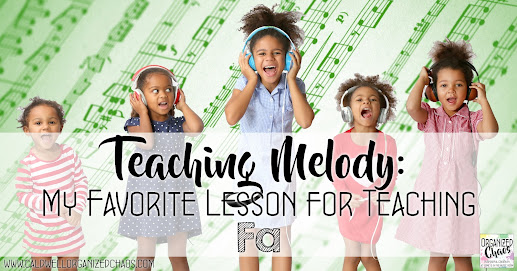My favorite song to use to introduce fa is "One Bottle of Pop". I'm also introducing partner singing in 4th grade, so this song is the perfect way to practice partner singing and also introduce the last solfege note in the same song! I'm sure most people have heard the song but for those who may not know, the song has 3 short verses that can be sung at the same time as a partner song- this video shows the melodies so you can hear how they go together. I actually lived in Edinburgh, Scotland for a year in elementary school and learned this song there so I teach the lyrics I learned there, which are slightly different than the ones I see U.S. Americans using online:
After learning each of the 3 verses separately with motions, I ask students to aurally identify the solfege of the first verse, which is incredibly easy with just do and sol. Then I tell them I want to figure out the solfege of the very end of the last verse and work backwards, so we start with the last note do and I ask them to aurally and visually identify the solfege from do back to the 2 eighth note "fa"s, which comes naturally since it is just a scale. There's fa! I like using this phrase to introduce the note because the phrase starts on fa and makes it easy to hear the tonality of the note and how it leans into mi. Once we've figured that phrase out and officially added the final note fa to our diatonic scale, I ask them to visually identify the solfege of the beginning of the second verse to see fa in a scale passage going from do to sol. Then we practice singing the entire song in solfege with hand signs, reading from the notation. Students are usually pretty surprised to find that they're able to do that pretty easily!
By 4th grade students are already aware that the note between mi and sol is fa, so introducing the note is not a major step. But it is a big deal that they now know the full scale and will be expected to use them all going forward! We always have a "solfege celebration" afterwards with Maria Ellis' Soul-fege Slide- I like to use this to practice the hand signs and solfege notes the next few classes after that as well:
Once they've gotten enough practice reading, hearing, and singing all of the solfege notes, I have them practice contextualizing the melodic and rhythmic notation concepts they've been working on by writing different rhythms on the staff with different pitches. Up until this point they have mostly either worked on writing rhythms in isolation on a 1-line staff, or writing melodies in isolation with just noteheads, so this is a big step for them. I have found that showing them on my computer how to take notes of different note values (like a set of beamed sixteenth notes or a dotted half note) and drag it onto the staff in different places helps them understand how the two concepts come together. We practice picking out different rhythms and putting them in different places on the staff on the computer together, then I have them work in groups to create a rhythm using rhythm cards, then write that rhythm on the treble clef staff to create a melody.
It is so much fun to see the excitement on the students' faces when they realize they have unlocked the entire set of solfege notes after all those years of practice! And they love the partner song because we make it silly with motions to exaggerate the nonsense lyrics. I hope you enjoy using these lessons with your students! You can see all of my lesson plans for melodic concepts all the way from teaching high and low in early childhood through the full progression of solfege notes in 1st through 4th grade, and practicing note letter names in treble and bass clef, in this post.




No comments :
Post a Comment